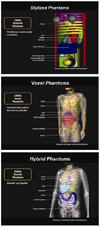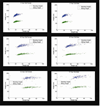Hybrid computational phantoms for medical dose reconstruction
- PMID: 20039051
- PMCID: PMC2855752
- DOI: 10.1007/s00411-009-0260-x
Hybrid computational phantoms for medical dose reconstruction
Abstract
As outlined in NCRP Report No. 160 of the US National Council on Radiation Protection and Measurements (NCRP), the average value of the effective dose to exposed individuals in the United States has increased by a factor of 1.7 over the time period 1982-2006, with the contribution of medical exposures correspondingly increasing by a factor of 5.7. At present, medical contributors to effective dose include computed tomography (50% of total medical exposure), nuclear medicine (25%), interventional fluoroscopy (15%), and conventional radiography and diagnostic fluoroscopy (10%). An increased awareness of medical exposures has led to a gradual shift in the focus of radiation epidemiological studies from traditional occupational and environmental exposures to those focusing on cohorts of medical patients exposed to both diagnostic and therapeutic sources. The assignment of organ doses to patients in either a retrospective or a prospective study has increasingly relied on the use of computational anatomic phantoms. In this paper, we review the various methods and approaches used to construct patient models to include anthropometric databases, cadaver imaging, prospective volunteer imaging studies, and retrospective image reviews. Phantom format types--stylized, voxel, and hybrid--as well as phantom morphometric categories--reference, patient-dependent, and patient-specific--are next defined and discussed. Specific emphasis is given to hybrid phantoms-those defined through the use of combinations of polygon mesh and non-uniform rational B-spline (NURBS) surfaces. The concept of a patient-dependent phantom is reviewed, in which phantoms of non-50th percentile heights and weights are designed from population-based morphometric databases and provided as a larger library of phantoms for patient matching and lookup of refined values of organ dose coefficients and/or radionuclide S values. We close with two brief examples of the use of hybrid phantoms in medical dose reconstruction--diagnostic nuclear medicine for pediatric subjects and interventional fluoroscopy for adult patients.
Figures











Comment in
-
Comment on "Hybrid computational phantoms for medical dose reconstruction" by Bolch et al.Radiat Environ Biophys. 2010 Aug;49(3):499-500; author reply 501-2. doi: 10.1007/s00411-010-0277-1. Epub 2010 Mar 23. Radiat Environ Biophys. 2010. PMID: 20309705 No abstract available.
References
-
- Amis ES, Jr, Butler PF, Applegate KE, Birnbaum SB, Brateman LF, Hevezi JM, Mettler FA, Morin RL, Pentecost MJ, Smith GG, Strauss KJ, Zeman RK. American College of Radiology white paper on radiation dose in medicine. J Am Coll Radiol. 2007;4:272–284. - PubMed
-
- Athar BS, Paganetti H. Neutron equivalent doses and associated lifetime cancer incidence risks for head & neck and spinal proton therapy. Phys Med Biol. 2009;54:4907–4926. - PubMed
-
- BEIR. Health risks from exposure to low levels of ionizing radiation: BEIR VII - Phase 2. Washington, DC: National Research Council; 2005. - PubMed
-
- Bolch WE, Eckerman KF, Sgouros G, Thomas SR. MIRD Pamphlet No. 21 – A generalized schema for radiopharmaceutical dosimetry: Standardization of nomenclature. J Nucl Med. 2009;50:477–484. - PubMed
-
- Clairand I, Bouchet LG, Ricard M, Durigon M, Di Paola M, Aubert B. Improvement of internal dose calculations using mathematical models of different adult heights. Phys Med Biol. 2000;45:2771–2785. - PubMed
Publication types
MeSH terms
Grants and funding
LinkOut - more resources
Full Text Sources
Research Materials

